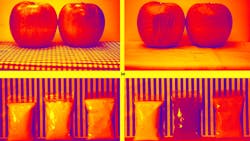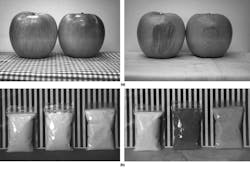Novel Sensor Process Delivers Single-Chip SWIR and Visible Light Capture
Demand for imaging in the shortwave-infrared (SWIR) range (between 1000 and 2000 nm) has been on the rise in recent years. Sensors for these SWIR wavelengths prove critical in industries such as food inspection. They provide the ability to see below the surface; for example, detecting bruises on apples earlier to stop an entire crop from going bad (Fig. 1a).
Similarly, the signature SWIR wavelength reflected by a substance (Fig. 1b) can detect and prevent poisonous food contaminants entering the supply chain. Doing so allows for a highly cost-effective tool to identify even small amounts of a contaminant in complex mixes. For example, a horsemeat contamination of beef can be identified using four wavelengths across the visible (515, 595, 650 nm) and SWIR (880 nm) wavelengths.
Indeed, with hyperspectral imaging potentially set to play a key role in preventing future food contamination events, it’s not a surprise that many governments—including the EU and U.S.—have approved and are funding projects to further evaluate its potential.
SWIR imaging also proves useful in security and astronomy, as well as in diverse sectors from silicon-wafer and flat-panel display inspection to art restoration, and from drug discovery to autonomous vehicles. It’s even been shown to visualize brain tumors and enable non-invasive detection.
Legacy SWIR Sensor Capabilities
Traditionally, image capture in the SWIR spectrum couldn’t be done using the same sensor technology as for visible light. Visible-light applications (400 to 700 nm) typically employ CMOS image sensors, a substrate that allowed the pixel pitch of visible-light sensors to shrink quickly, giving ever greater resolutions. In addition, CMOS gives a digital output. However, CMOS can’t capture light with wavelengths above 1100 nm.
To overcome that, SWIR imaging utilizes indium-gallium-arsenide (InGaAs) technology. Legacy InGaAs technologies, though, suffered from low resolutions, and the nature of the bump bonding used prevented further miniaturization (Fig. 2). In addition, this bonding process produced an analog output, and the structure of legacy InGaAs sensors prevented light in the visible spectrum from reaching the photoelectric conversion layer.
Not only were resolutions kept low, it was also costly to create a hyperspectral camera capable of capturing both visible and SWIR light. Below we look at how these three key limitations (resolution, sensitivity, and analog output) can be addressed with a new process technology.
Improved Resolution
Resolution/miniaturization issues from the traditional bump connection between the InGaAs layer (where the photoelectric conversion takes place) and the readout circuit (Si layer) can be solved by adopting a copper-to-copper (Cu-Cu) hybridization between a III-V InGaAs/InP (indium gallium arsenide/indium phosphide) of the photodiode array (PDA), and the Si layer.
This new approach was first outlined in December 2019 at the International Electron Device Meeting by a team of Sony researchers. This approach opens the door to higher pixel densities for the next generation of SWIR sensors and allows for the creation of smaller sensors and greater resolutions.
For context, SWIR chips using the legacy bump-bonding process have a pixel pitch of approximately 10 µm. Conversely, the first generation of SWIR sensors based on the new technology shrinks the pitch to 5 µm, enabling 4X the number of pixels in the same space to create an SXGA (1296 × 1032) resolution SWIR sensor on a 1/2-type (8.2 mm) footprint and a VGA (656 × 520) resolution sensor with a 1/4-type (4.1 mm) footprint.
Increased Sensitivity
The ability to capture both SWIR and visible light on the same sensor reduces the cost for applications requiring hyperspectral images. Reducing the thickness of the InP layer, which for legacy sensors was the key limiting factor in the amount of visible light that could penetrate it, makes this possible.
A thinner InP layer reduces the absorption of visible light and enables it to transmit to the InGaAs layer underneath. Thus, imaging is possible in a broad range of wavelengths from 0.4 to 1.7 μm (relative quantum efficiency >70% from 400 to 1650 nm). Furthermore, the thinner InP layer increases the relative quantum efficiency of SWIR wavelengths, with >90% of light from wavelengths between 900 to 1600 nm transmitting through the InP layer (Fig. 3).
This improvement allows the sensor to capture both SWIR-visible-light hyperspectral images to significantly reduce image camera-system processing loads, as well as overall system bill of materials versus multi-sensor solutions.
Digital Output
By shifting to a Cu-Cu hybridization, the InGaAs sensor also can output a digital signal without the use of a digital conversion circuit. It thus simplifies design and gives SWIR cameras using this technology the same performance as current industrial CMOS image sensors.
Conclusion
Hyperspectral and SWIR technologies deliver significant benefits in food and agriculture for quality inspection and contamination detection. However, they can be used across a wide range of industries, from art restoration to medicine to automotive.
By replacing bump connections with Cu-Cu bonding, it’s possible to significantly improve on legacy InGaAs sensor limitations: quadrupling the pixel density, enabling SWIR and visible light capture on a single chip. and delivering a digital output.
Sony launched its first two SWIR sensors based on this technology in July 2020.
Piotr Papaj is European Corporate Communications Manager at Sony Europe.
About the Author
Piotr Papaj
European Corporate Communications Manager, Sony Europe
Piotr Papaj has been with Sony for close to 10 years. He is involved in several educational projects related to televisions and image sensors.



